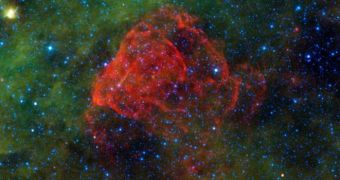Data from the NASA Wide-field Infrared Survey Explorer (WISE) telescope reveal the Puppis A supernova remnant with unprecedented accuracy, showing off its rose-like shape. The stellar explosion that produced this structure occurred some 3,700 years ago.
At that time, some of our ancestors must have been puzzled to see a new star in the sky, brightening up and then slowly fading out of existence over the course of a few months. At one point, it had fully disappeared, and then slowly made its way out of remembrance.
It was only millennia later that astronomers again found the object, which had in the mean time expanded vastly in space. It now resembles a cosmic rose. This view is especially beautiful because it was collected in infrared wavelengths, which the human eyes cannot detect.
The green hues you can see are not from Puppis A, but from the Vela supernova remnants, which is located four times closer to Earth than its counterpart. The event that produced it also gave birth to the renowned Vela Pulsar, some 12,000 years ago, experts from the Jet Propulsion Laboratory explain.

 14 DAY TRIAL //
14 DAY TRIAL //